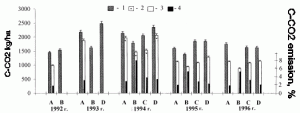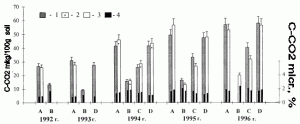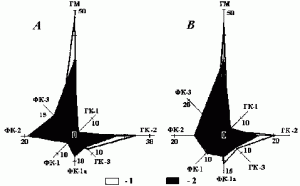Siberian Institute of Plant Physiology and Biochemistry, SB RAS, Irkutsk
Head of the Institute:
Ryurik K.Salyaev, Corresponding Member of the RAS,
P.O.Box 1243, Irkutsk, 664033, Russia
Tel. (3952)460721, (3952)462478, Fax (3952)510754,
email: agroeco@sifibr.irk.ru
Principal researchers:
L.V.Pomazkina, Doctor of Biological Sciences, Head of the Laboratory of Agroecology
Project objectives
To study the processes of microbial destruction of organic matter in grey forest arable soils depending on hydrothermal conditions, the character and the level of industrial pollution.
1. To assess soil properties, the state of organic matter, the character and the level of industrial pollution.
2. To study the effect of hydrothermal conditions on seasonal and many-year carbon dynamics of microbial biomass and CO2 emission from agroecosystem soils.
3. To assess microbiological transformation of organic matter and carbon losses depending on industrial pollution of soils.
4. To estimate the contribution of agroecosystem soils into CO2 entry into the atmosphere.
Background and significance of objectives
Monitoring observations of the state of humus, the content of carbon in the microbial biomass and CO2 emission in agroecosystem soils including industrially polluted ones have been performed since 1990 (Figs. 1 and 2). The project envisages to continue the investigations on the basis of ecological monitoring in two field stations in the forest-steppe of Pribaikalie, involving examination of soil properties and their pollution, the state of humus (Fig. 3), its microbiological transformation and CO2 emission from the soils in many-years field experiments.
Research plan: approaches and methods
Close attention has been paid to estimation of the contribution of anthropogenic CO2 sources in formation of “the greenhouse effect” in studies of global changes of environment and climate.
The use of soils in agriculture is followed by changes in carbon cycles and other biophilic elements associated with enhanced processes of mineralisation of the organic mater, especially under conditions of industrial pollution. As a result, agroecosystems are a significant source of CO2 in the biosphere as distinguished from other ecosystems (forests, steppe, bog). The soil microbial complex is the most vulnerable component of the agroecosystem, dysfunction of which results in the change of the activity of the processes of organic matter transformation in the soil. Observations of the seasonal and many-year dynamics of carbon of microbial biomass and CO2 emission provide information on the response of the agroecosystem to climate changes and industrial pollution of soils.
Research plan: approaches and methods
The methods of systemic approach and comparative analysis are used in the investigations. Agroecosystems are considered as integral objects of the components interacting with each other (soil – microorganisms – plants – atmosphere). Interrelating observations of hydrothermal parameters, the content of microbial biomass (the method of rehydratation, Blagodatsky et al., 1987) and CO2 emission after 7-12 days (the method of absorption, Sharkov, 1987) are conducted in the system of agroecological monitoring in many-year field experiments. The fraction and group composition of humus in determined by the Ponomareva-Plotnikova method (1964).
Expected results
It is envisaged to show the effect of hydrothermal conditions on seasonal and many-year dynamics of carbon of microbial biomass and CO2 emission from soils, to find the contribution of agroecosystems in CO2 release into the atmosphere, to assess microbiological transformation of organic matter and carbon losses depending on industrial soil pollution. Data to be obtained are of interest for assessment of changes of the environment and climate both in regional and global aspects. They can serve as a scientific basis for elaboration of the system of rational nature use and ecologically safe agriculture on industrially polluted soils.
List of publications of participants related to the project
-
Pomazkina L.V., Lubnina E.V., Zorina S.Yu., Kotova L.G. The dynamics of CO2 evolution in grey forest soil in the Baikal forest-steppe // Biol. Fertil. Soils. – 1996. – Vol. 23. – P. 327-331.
-
Pomazkina L.V., Zorina S.Yu., Petrova I.G. Transformation of nitrogen and carbon bound compounds of humus substances in grey forest soil of the Cisbaikal forest steppe // Eurasian Soil Science. – 1997. – Vol. 29. – P. 1231-1239.
-
Pomazkina L.V., Lubnina E.V., Kotova L.G., Lesnykh N.P., Lavrent’eva. The evolution of carbon and nitrogen into the atmosphere from agroecosystems on the soils of the lake Baikal region subjected to technogenic contamination // Agricultural Chemistry. – 1997. – Vol. 1, ą 2. – P. 193-198.
-
Pomazkina L.V., Lubnina E.V., Zorina S.Yu., Kotova L.G., Khortolomei I.V. Dynamics of CO2 emission from the grey forest soil in the forest-steppe of the Cisbaikal region // Eurasian Soil Science. – 1997. – Vol. 29. – P. 1355-1359.
-
Pomazkina L.V., Lubnina E.V., Kotova L.G. Carbon and nitrogen emission in agroecosystem of Eastern Siberia // Z. Pflanzenernahr. und Bodenk. – 1999. – Vol. 162. – P. 163-169.
-
Pomazkina L.V., Lubnina E.V., Lesnykh N.P. CO2 emission in different soil types of the forest-steppe of Pribaikalie // Pochvovedenie (Soil Science), 1998. – ą 7. – P. 876-882 (in Russ.).
-
Pomazkina L.V., Kotova L.G., Lubnina E.V. Biogeochemical monitoring and assessment of regimes of functioning of agroecosystems in industrially polluted soils. – Novosibirsk: Nauka, 1999. – 220 p.
Fig. 1. Carbon emission from soils per a growing season in different years.
![]() A – non-polluted grey forest soil; industrially polluted soil: B – alluvial; C – grey forest; D – soddy-meadow. Treatments: 1 – wheat, N60P60K60; 2 – fallow after wheat; 3 – many-year fallow; 4 – carbon losses, C-CO2/Corg, %
A – non-polluted grey forest soil; industrially polluted soil: B – alluvial; C – grey forest; D – soddy-meadow. Treatments: 1 – wheat, N60P60K60; 2 – fallow after wheat; 3 – many-year fallow; 4 – carbon losses, C-CO2/Corg, %
Fig. 2. The content of C-biomass in soils on the average per season in different years, X+S, n=24
A – non-polluted grey forest soil; industrially polluted soils: B – alluvial; C – grey forest; D – soddy-meadow.
Treatments: 1 – wheat, N60P60K60; 2 – fallow after wheat; 3 – many-year fallow; 4 – Cmicr./Corg., %
Fig. 3. The distribution of carbon (1) and nitrogen (2) in the fractions of humus substances (% of total) in grey forest arable soils varying in fluoride pollution.
Soils: A, 1.5 maximum permissible concentration; B, 6 maximum permissible concentration.



